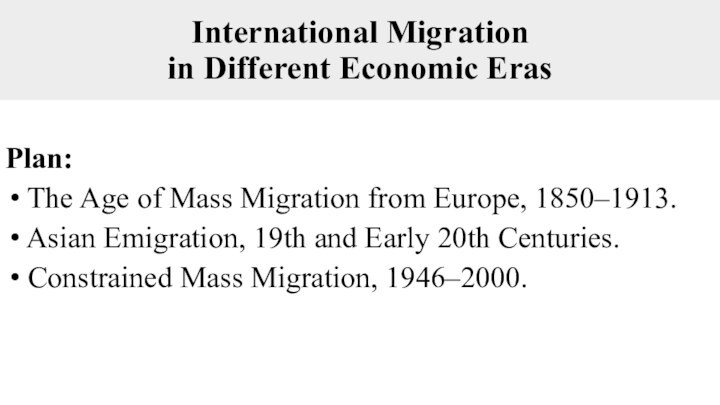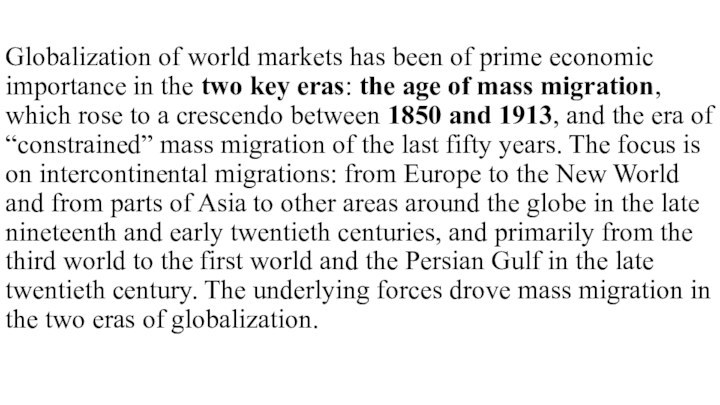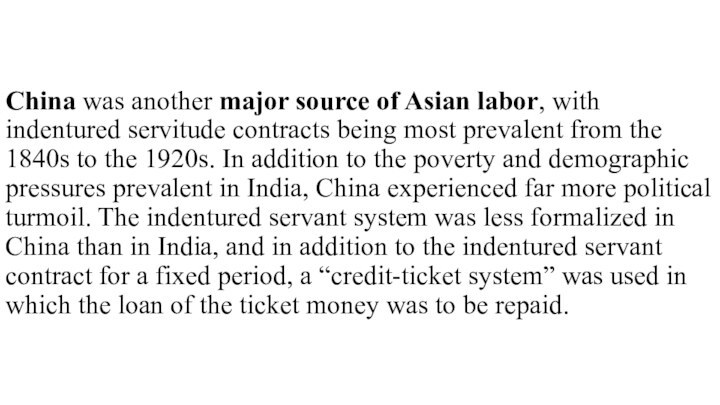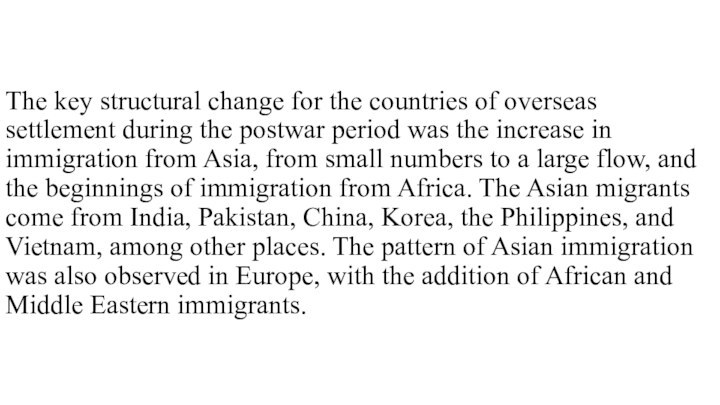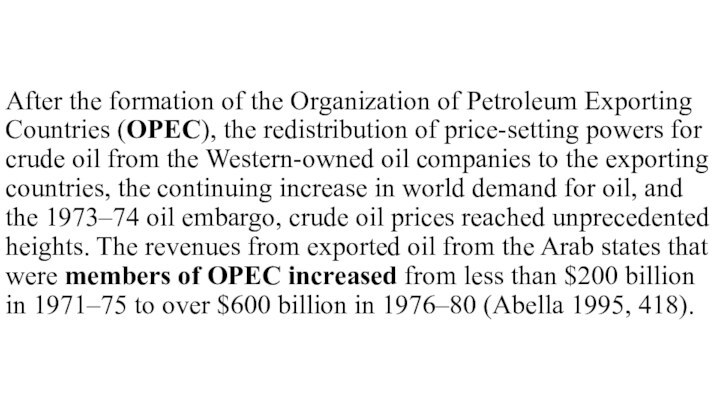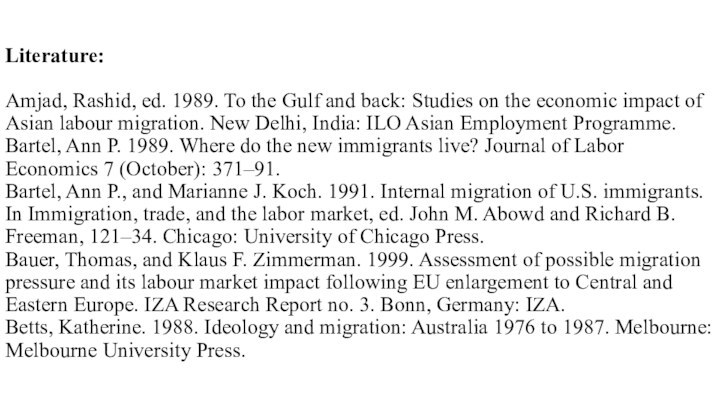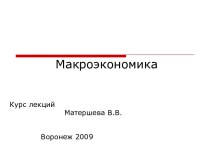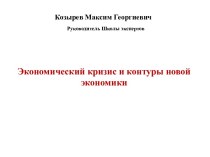Слайд 2
New terms:
● indenture – договор; соглашение в двух
экземплярах;
● dub – дублировать;
● remittance – денежный перевод;
● repatriate
– репатриант; возвращаться на родину;
● (migration) stream – поток;
● incentive – стимул;
● unfettered – освобожденный;
● restriction – ограничение;
● calculus – исчисление.
Слайд 3
What Drives Mass Migrations?
“Mass migrations are driven by
economic incentives, and numerous studies testify to that fact.
The era of mass migration before the First World War, when international migration was relatively unfettered by restrictions, is a good time to examine the forces that determined patterns of migration. The bias toward certain emigrant characteristics reflects the economic calculus underlying their migration” (Chiswick 2000).
In Adam Smith’s words, “man is of all sorts of luggage the most difficult to be transported.”
Слайд 4
Globalization in the labor market is qualitatively different
from globalization of goods or asset markets. With international
migration, the factor of production (labor services) crosses national boundaries embodied in individuals.
International migration alters the labor supply and the demographic characteristics of both the sending and the receiving countries. Moreover, it influences economic growth, patterns of trade, income distribution, and the distribution of political power within and between countries.
Слайд 5
Globalization of world markets has been of prime
economic importance in the two key eras: the age
of mass migration, which rose to a crescendo between 1850 and 1913, and the era of “constrained” mass migration of the last fifty years. The focus is on intercontinental migrations: from Europe to the New World and from parts of Asia to other areas around the globe in the late nineteenth and early twentieth centuries, and primarily from the third world to the first world and the Persian Gulf in the late twentieth century. The underlying forces drove mass migration in the two eras of globalization.
Слайд 6
It is estimated that about 700,000 Europeans migrated
to North America and the Caribbean between 1650 and
1780, more than half to the mainland colonies. By the end of the eighteenth century fixed-period contract servitude for Europeans was in decline, partly because of diminishing European supply, but more importantly because of the expansion of another form of recruitment: slavery.
Слайд 7
The sharp rise in slave imports from the
late 17th century, first to the West Indies and
then to the mainland colonies of South Carolina prevented the implicit wages of indentured servants from rising (i.e., prevented the contract length from falling) and slowed the growth in numbers (Grubb 1992, 196).
By the end of the 18th century fixed-period contract servitude for Europeans was in decline, partly because of diminishing European supply, but more importantly because of the expansion of another form of recruitment: slavery.
Слайд 8
The slave trade continued to grow, particularly to
the cotton and tobacco growing colonies and states on
the mainland of North America and to the sugar growing colonies of the Caribbean.
By the end of the 18th century something like eight million had journeyed to the New World, but largely as slaves from Africa (about 7 million) (see Lovejoy 1983, 478, 496).
It is estimated that about 700,000 Europeans migrated to North America and the Caribbean between 1650 and 1780, more than half to the mainland colonies.
Слайд 9
It was not until after the middle of
the 19th century that mass migration can really be
said to have taken hold.
The first wave of the late 1840s was associated with famine and revolution in Europe, and the second wave with the shift in ocean transport from sail to steam. (Keeling, 1999)
In the first half of the 19th century the dominant source of migrants
was the British Isles. These were joined from the 1840s by a stream
of emigrants from Germany, followed, after 1870, by a rising tide from
Scandinavia and elsewhere in northwestern Europe. Emigration surged
from southern and eastern Europe from the 1880s.
Слайд 10
It came first from Italy and parts of
the Austro-Hungarian empire, and then from Poland, Russia, Spain,
and Portugal. About 60 percent of all European emigrants went to the United States.
However, from the 1870s significant flows developed—largely from Italy, Spain, and Portugal—to South America, principally Brazil and Argentina, that is, from Romance language origins to Romance language destinations.
Слайд 11
The characteristics of the emigrants also changed. It
was no longer a “family” migration. The mass migrants
were typically young and single, and about two-thirds of them were male. More than three-quarters of the immigrants entering the United States between 1868 and 1913 were aged sixteen to forty at a time when 42 percent of the U.S. population was in this age group.
Слайд 12
The return migration rates were very high for
some groups, for example, Italian and Greek immigrants, and
very low for other groups, such as eastern European and Russian, Jews, who viewed themselves as refugees and, more than other groups, migrated in a family context.
Although the discussion of the 19th century and pre–World War I intercontinental migration has focused on the emigration of Europeans to the New World, large-scale migrations were taking place in other parts of the world.
Слайд 13
Although the discussion of the nineteenth century and
pre–World War I intercontinental migration has focused on the
emigration of Europeans to the New World, large-scale migrations were taking place in other parts of the world.
The increased globalization of the political system through the spread of European colonization in the 19th century to Asia, Africa, and the Pacific and Indian Ocean islands resulted in increased intercontinental trade, with sugar, rubber, tin, and other primary products being produced in the colonies, much of it for export to Europe and North America.
Слайд 14
The establishment of colonial plantation agriculture and mining,
and the development of transportation and communication, increased the
demand for low-cost pliant labor. In the absence of slavery, colonial governments and business enterprises sought (seek) fresh sources and instruments to attract the labor for these activities. The new source became Asia, and in particular India, China, and Japan. The new instrument was a return to an earlier means of financing migration—indentured contract labor.
Слайд 15
Asia offered a large supply of low-cost unskilled
labor, but even with the cost of international migration
lower in the 19th century than in earlier centuries, Asian laborers were too poor to finance the move. The contracts (for Indian workers) were typically of five years’ duration. As a result, Asian communities began developing in East Africa and southern Africa, North America, Latin America, and Oceania, and nonindigenous Asian communities developed in Southeast Asia.
Слайд 16
China was another major source of Asian labor,
with indentured servitude contracts being most prevalent from the
1840s to the 1920s. In addition to the poverty and demographic pressures prevalent in India, China experienced far more political turmoil. The indentured servant system was less formalized in China than in India, and in addition to the indentured servant contract for a fixed period, a “credit-ticket system” was used in which the loan of the ticket money was to be repaid.
Слайд 17
Japan, too, was a source of emigrant labor,
with somewhat fewer than one million emigrants from the
mid-nineteenth century to the early 1930s (Shimpo 1995). Labor-recruiting agents and the labor contract system were used. The Japanese workers went to Hawaii and the mainland United States, as well as to South America, primarily Peru and Brazil, as indentured servants or as recruited free immigrants.
Слайд 18
Mass migration fell sharply as war and depression
halted the globalization trend and immigration policies entered a
new age of restriction.
Emigration restrictions, introduced by some countries, such as the Soviet Union, also limited opportunities for international migration.
Слайд 19
The share of the United States in intercontinental
emigration from Europe was 51 percent in 1921–25, and
32 percent (of a much smaller total) in 1931–35, in part because of the U.S. Limits on immigration. Some southern European migrants were diverted to Brazil and Argentina, the latter receiving 3 million in the 1920s, although as many as 2 million returned.
Слайд 20
But emigration from everywhere in Europe fell in
the 1920s, with the exception of Poland and other
eastern European countries. And apart from Jewish emigration from Germany, the economic maelstrom of the 1930s completed the process of deglobalization of the international labor market. Indeed, in some years during the Depression of the 1930s the return migration to Europe exceeded immigration, resulting in a negative net migration rate to the United States.
Слайд 21
The post-WWII period has seen a dramatic decline
in the costs of travel as a result of
the shift from sea to air travel.
After the flow of migrants has been partially controlled by immigration policies introduced in the major receiving countries earlier in the century. Immigration policies changed sharply in the 1960s in the United States, Canada, and Oceania, with a shift away from quotas that favored immigrants from northwest Europe.migration resumed, the flow of migrants has been partially controlled by immigration policies introduced in the major receiving countries earlier in the century. Immigration policies changed sharply in the 1960s in the United States, Canada, and Oceania, with a shift away from quotas that favored
immigrants from northwest Europe.
Слайд 22
The proportion of foreign born in the population
was 15 percent in 1910, falling to a low
of 4.7 percent in 1970, then, with the growing postwar immigration, increasing to 8 percent in 1990 and 10 percent in 2000.
Although the immigration rate is lower than at its peak in the first decade of the 20th century, its contribution to population and labor force growth is similar because the rate of natural increase has also declined.
Слайд 23
The key structural change for the countries of
overseas settlement during the postwar period was the increase
in immigration from Asia, from small numbers to a large flow, and the beginnings of immigration from Africa. The Asian migrants come from India, Pakistan, China, Korea, the Philippines, and Vietnam, among other places. The pattern of Asian immigration was also observed in Europe, with the addition of African and Middle Eastern immigrants.
Слайд 24
Among five main European destination countries, immigration from
developing countries rose from 97,000 in 1975–79 to 225,000
in 1990–93.
For Germany alone, between 1975–79
and 1990–93 immigration from northern Africa and western Asia rose from 20,000 to 67,000 per annum, while that from sub-Saharan Africa rose from a mere 1,200 to 22,000 per annum.
Слайд 25
After the formation of the Organization of Petroleum
Exporting Countries (OPEC), the redistribution of price-setting powers for
crude oil from the Western-owned oil companies to the exporting countries, the continuing increase in world demand for oil, and the 1973–74 oil embargo, crude oil prices reached unprecedented heights. The revenues from exported oil from the Arab states that were members of OPEC increased from less than $200 billion in 1971–75 to over $600 billion in 1976–80 (Abella 1995, 418).
Слайд 26
The result was an extraordinary increase in the
demand for foreign workers. Contract workers from South Korea
reached a peak in 1982 of nearly 200,000 and then declined sharply, whereas those from the Indian subcontinent and Indonesia followed a rising trend.
Contract workers from South Korea reached a peak in 1982 of
nearly 200,000 and then declined sharply, whereas those from the Indian subcontinent and Indonesia followed a rising trend (UN 2000, 62, 110).
Слайд 27
As a result of the Iraqi invasion of
Kuwait in 1990 and the resulting Persian Gulf War
(1991), many Arab workers (particularly Palestinians and Yemenis whose leaders sided with Iraq) left or were expelled from the Arab Persian Gulf states. Primarily for political reasons, the reliance on Asian as
distinct from Arab workers has since increased even further.
For the sending countries, of course, the arrangement
provided benefits in the form of higher-wage jobs for many of their nations, contracts for their construction firms, and substantial foreign exchange in the form of remittances and repatriated wages and profits (Amjad 1989).
